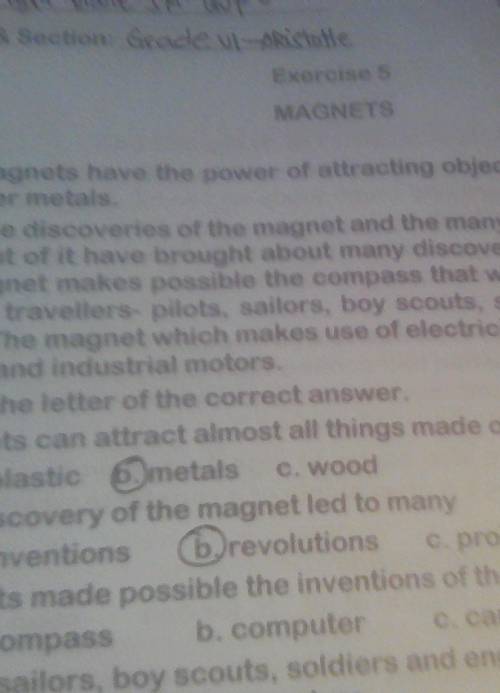MAGNETS
1.Magnets can attract almost all things made of
a. plastic b. metals c. wood
2.Th...

Chemistry, 03.12.2020 18:00 aaliyahrice02
MAGNETS
1.Magnets can attract almost all things made of
a. plastic b. metals c. wood
2.The discovery of the magnet led to many
a. inventions b. revolutions
c. problems
3.Magnets made possible the inventions of the
a. compass b. computer c. camera
4.Pilots, sailors, boy scouts, soldiers and engineers depend much on
a. compass b. electricity c. motors
5.Magnets also make use of
a. electricity b. gas c. water powder
6.Electric and industrial motor became possible after the discovery of
a. electricity b. magnets c. water power
7.Compass is most useful to
a. farmers b. teachers c. travellers
8.Motors make use of
a. magnets b. plastic c. wood
9.these days, magnets
a. are no longer used b. are still being used c. has been replaced
10.Compass, too
a. are no longer being used b. are still being used c. has been replaced.


Answers: 1
Another question on Chemistry

Chemistry, 22.06.2019 10:10
How do you identify the anode on a power source such as a battery? how do you identify the cathode? how are terms anion and cation?
Answers: 1

Chemistry, 22.06.2019 17:30
98 points you will be galileo perform the experiment to determine if objects with different mass fall at the same, or different, rates in the air and in a vacuum. before you conduct your experiment, you need to form a hypothesis. a hypothesis is a prediction of what you think will happen in the experiment. the hypothesis is a statement that describes “if” a certain set of circumstances are present “then” there will be a specific result that will occur. record your hypothesis here: record the results from step one of the experiment (dropping the objects in the air): first trial: second trial: third trial: record the results from step two of the experiment (dropping the objects in a vacuum): first trial: second trial: third trial: did the experiment support your hypothesis? using the data from your experiment, describe why you believe your hypothesis was either proven or disproven. what forces were acting on the objects dropped in the air? what force was acting on the objects dropped in the vacuum? part two: comparing forces choose two forces and compare and contrast these forces. you must provide two ways that they are alike and two ways that they are different. you may make a list, write in paragraph form, or make a chart. choose two forces and compare and contrast these forces. these must be different forces than used in the prior question. provide two ways that they are similar and two ways that they are different. you may make a list, write it out, or make a chart.
Answers: 3

Chemistry, 22.06.2019 17:30
Energy defines the different "states" of matter. in no more than 3 sentences, describe the amount of kinetic energy that each of the 3 states of matter possesses and relate that to the atom/molecular motion of each "state".
Answers: 2

Chemistry, 22.06.2019 19:30
Chlorine and water react to form hydrogen chloride and oxygen, like this: 2cl2 (g) + 2h2o (g) → 4hcl (g) + o2 (g) also, a chemist finds that at a certain temperature the equilibrium mixture of chlorine, water, hydrogen chloride, and oxygen has the following composition: compound concentration at equilibrium cl2 0.55m h2o 0.57m hcl 0.53m o2 0.34m calculate the value of the equilibrium constant kc for this reaction. round your answer to 2 significant digits.
Answers: 2
You know the right answer?
Questions


Mathematics, 10.04.2021 22:40

History, 10.04.2021 22:40


Mathematics, 10.04.2021 22:40

Mathematics, 10.04.2021 22:40


English, 10.04.2021 22:40



Spanish, 10.04.2021 22:40


Social Studies, 10.04.2021 22:50



Mathematics, 10.04.2021 22:50

Mathematics, 10.04.2021 22:50



Mathematics, 10.04.2021 22:50



